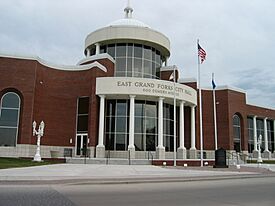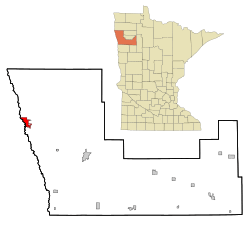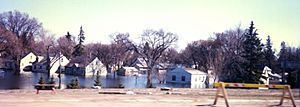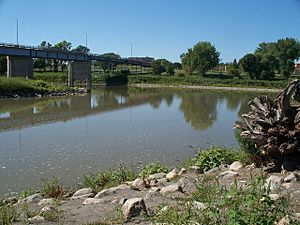East Grand Forks, Minnesota facts for kids
Quick facts for kids
East Grand Forks, Minnesota
|
|
|---|---|

East Grand Forks City Hall
|
|
| Nickname(s):
The Grand Cities
|
|

Location of East Grand Forks in Polk County, Minnesota
|
|
| Country | United States |
| State | Minnesota |
| County | Polk |
| Metro | Greater Grand Forks |
| Established | 1887 |
| Incorporated | April 13, 1887 |
| Government | |
| • Type | Council–manager government |
| Area | |
| • City | 5.946 sq mi (15.401 km2) |
| • Land | 5.946 sq mi (15.401 km2) |
| • Water | 0.000 sq mi (0.000 km2) |
| • Urban | 26.48 sq mi (68.59 km2) |
| • Metro | 3,407 sq mi (8,825 km2) |
| Elevation | 833 ft (254 m) |
| Population
(2020)
|
|
| • City | 9,176 |
| • Estimate
(2023)
|
8,929 |
| • Density | 1,521/sq mi (587.3/km2) |
| • Urban | 68,160 (US: 411th) |
| • Urban density | 2,574/sq mi (993.7/km2) |
| • Metro | 103,120 (US: 357th) |
| • Metro density | 30.3/sq mi (11.69/km2) |
| Time zone | UTC−6 (Central) |
| • Summer (DST) | UTC−5 (CDT) |
| ZIP Code |
56721
|
| Area code(s) | 218 |
| FIPS code | 27-17612 |
| GNIS feature ID | 2394599 |
| Highways | US 2, MN 220 |
| Sales tax | 7.375% |
East Grand Forks (also known as EGF) is a city in Polk County, Minnesota, United States. It's located on the eastern side of the Red River of the North. Right across the river is the bigger city of Grand Forks, North Dakota.
Together, East Grand Forks and Grand Forks are often called Greater Grand Forks. This area is home to about 104,362 people, according to the 2020 Census. East Grand Forks itself had 9,176 people in 2020, making it the largest community in Polk County.
Contents
History of East Grand Forks
The area where East Grand Forks is located got its name because it's east of Grand Forks, North Dakota. A post office opened here in 1883. The city was officially started on April 13, 1887.
The Great Flood of 1997
In 1997, East Grand Forks and Grand Forks faced a huge challenge. A major flood from the Red River caused a lot of damage. Everyone in East Grand Forks had to leave their homes for safety. Almost every house was damaged by the water.
After the flood, some neighborhoods had to be taken down because they were too damaged. The city decided to turn the flooded areas near the rivers into a large park. This park is called the Greater Grand Forks Greenway. It's a fun place for people to enjoy the outdoors. A similar park was built on the other side of the river in Grand Forks. These parks, with their trees and green spaces, help soak up floodwaters. This protects the cities from future floods. Also, new dikes (special walls) were built to keep the city safe.
East Grand Forks has rebuilt and grown stronger since the flood. New businesses, like a Cabela's sporting goods store and movie theaters, have opened downtown.
Geography of East Grand Forks
East Grand Forks is in a very flat and fertile area called the Red River Valley. This valley was formed by a huge ancient glacial lake called Lake Agassiz.
The city is built around the Red Lake River, which flows into the Red River right in town. The main part of the city, including the original downtown, is north of the Red Lake River. South of the river is an area known as "The Point." This land gets very narrow where the Red and Red Lake rivers meet. "The Point" has many homes.
The city covers about 5.946 square miles (15.401 square kilometers) of land. There is no water area within the city limits.
People in East Grand Forks
| Historical population | |||
|---|---|---|---|
| Census | Pop. | %± | |
| 1890 | 795 | — | |
| 1900 | 2,077 | 161.3% | |
| 1910 | 2,533 | 22.0% | |
| 1920 | 2,490 | −1.7% | |
| 1930 | 2,922 | 17.3% | |
| 1940 | 3,511 | 20.2% | |
| 1950 | 5,049 | 43.8% | |
| 1960 | 6,998 | 38.6% | |
| 1970 | 7,607 | 8.7% | |
| 1980 | 8,537 | 12.2% | |
| 1990 | 8,658 | 1.4% | |
| 2000 | 7,501 | −13.4% | |
| 2010 | 8,601 | 14.7% | |
| 2020 | 9,176 | 6.7% | |
| 2023 (est.) | 8,929 | 3.8% | |
| U.S. Decennial Census 2020 Census |
|||
In 2020, East Grand Forks had 9,176 people living there. There were about 3,599 households. The average household had about 2.66 people. The city's median household income was $81,783 in 2022.
Most people in East Grand Forks are White (82.31%). About 7.42% are African American, and 1.53% are Native American. People of Hispanic or Latino background make up about 6.19% of the population. The average age in the city is about 34.5 years old.
Economy
East Grand Forks has many different types of jobs. Here are some of the biggest employers in the city:
| # | Employer | Number of employees | Percentage |
|---|---|---|---|
| 1 | East Grand Forks Public Schools ISD 595 | 367 | 14.62% |
| 2 | American Crystal Sugar Company | 320 | 12.74% |
| 3 | R. J. Zavoral and Sons, Inc. | 151 | 6.01% |
| 4 | City of East Grand Forks | 95 | 3.78% |
| 5 | Northland Community & Technical College | 77 | 3.07% |
| 6 | Sacred Heart | 75 | 2.99% |
| 7 | Northern Valley | 70 | 2.79% |
| 8 | Sanford Health | 59 | 2.35% |
| 9 | Vallet Markets | 52 | 2.07% |
| 10 | Mayo Manufacturing, Inc. | 35 | 1.39% |
| Total | — | 1,301 | 51.83% |
Education
East Grand Forks has several schools for students from kindergarten through high school. There are two elementary schools, a middle school, and East Grand Forks Senior High School. About 1,758 students attend these public schools.
There are also two private Christian schools. Sacred Heart School is a Catholic school that welcomes students from both North Dakota and Minnesota. Riverside Christian School is another private school for elementary, middle, and high school students.
Higher Education
For students who want to continue their education after high school, East Grand Forks has Northland Community & Technical College. This college also has another campus in Thief River Falls, Minnesota. The East Grand Forks campus started offering classes in 1973. It has grown a lot over the years.
Across the Red River in Grand Forks, students can also attend the University of North Dakota.
Getting Around East Grand Forks
East Grand Forks has bus routes that connect the city to Grand Forks, North Dakota. These buses are part of Cities Area Transit.
Main roads in the city include U.S. Route 2 and Minnesota Highway 220. Other important roads nearby are Interstate Highway 29 and U.S. Highway 81.
Shopping and Fun
East Grand Forks has a downtown area with shops, a 12-screen movie theater, and a Cabela's sporting goods store. You can also find several local restaurants there.
After the 1997 flood, the land along the rivers was turned into a park and recreation area. This is part of the Greater Grand Forks Greenway. It's a great place for people to enjoy nature and outdoor activities. The trees and plants in this area also help protect the city by absorbing floodwaters. In the northern part of town, there's a public golf course called Valley Golf Course.
Local Events
East Grand Forks hosts many fun events throughout the year. Some popular ones include:
- Catfish Days: This event is based on a summer catfishing tournament. People come from all over the United States and Canada to take part in one of the region's largest fishing tournaments.
- Frosty Bobber: Another fishing tournament.
- Heritage Days: A celebration of the city's history.
- Arts and Crafts Shows: Where local artists and crafters share their work.
East Grand Forks also shares some events with Grand Forks. These include the Potato Bowl parade and First Night, which is a New Year's celebration without alcohol. In June, the Grand Cities Art Fest takes place in both downtown areas. During the summer, there's an Art & Wine Walk each month. A farmer's market is also popular, offering local produce and crafts in the Town Square on Saturdays.
Media
East Grand Forks has its own weekly newspaper called The Exponent. For other news and entertainment, people in East Grand Forks usually use the media from Grand Forks. Radio stations KZLT and KGFK are licensed to East Grand Forks, but they broadcast from Grand Forks.
Notable People
- Kurt Knoff: An NFL safety who played for the Minnesota Vikings, Houston Oilers, and Denver Broncos.
- Pat Owens: Was the Mayor of Grand Forks during the 1997 Red River Flood in the United States.
- Molly Yeh: An author, restaurant owner, and host of the TV show "Girl Meets Farm."
See also
 In Spanish: East Grand Forks (Minnesota) para niños
In Spanish: East Grand Forks (Minnesota) para niños



